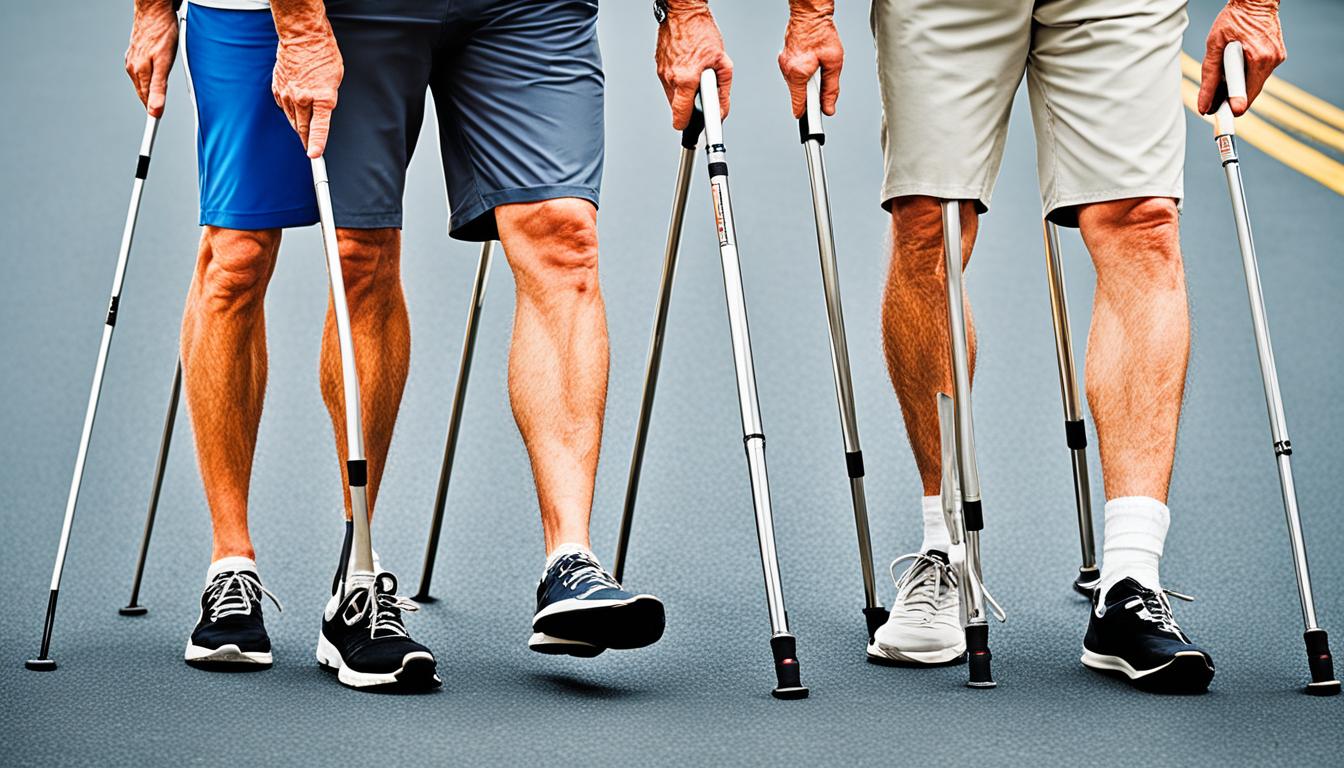Drop foot is also called foot drop syndrome. It means you can’t lift the front of your foot. It’s a symptom, not a disease, showing something is wrong with your nerves, muscles, or body structure. Sometimes, nerve damage, injury, or brain disorders cause it.
Doctors diagnose drop foot with exams and tests. Then, they might suggest braces, physical therapy, or stimulation. In some cases, surgery helps. But now, stem cell therapy shows promise as a new way to treat foot drop.
Key Takeaways:
- Drop foot, or foot drop syndrome, is the inability to raise the front part of the foot.
- It is a symptom of an underlying neurological, muscular, or anatomical problem.
- Common causes of foot drop include nerve damage, nerve injury, and spinal cord or brain disorders.
- Diagnosis involves a physical exam, imaging tests, and nerve tests.
- Treatment options for foot drop include braces, physical therapy, nerve stimulation, and surgery.
- Stem cell therapy is being explored as a potential breakthrough treatment for foot drop.
Symptoms of Foot Drop
Foot drop makes it hard to lift the front of your foot. You might drag your foot when walking. This leads to an unusual way of walking. People might lift their thighs higher or swing their legs out.
They do this to balance out the foot drop. Sometimes, the foot’s top skin and toes can feel numb too.
Common Symptoms of Foot Drop:
- Difficulty in lifting the front part of the foot
- Dragging the foot on the ground while walking
- Abnormal gait with a high thigh or wide leg swing
- Numbness in the top skin of the foot and toes
These symptoms are key for diagnosing foot drop and finding its cause. If you notice these signs, it’s crucial to see a doctor for checkup.
Related Symptoms:
Foot drop might come with other signs too, based on its cause. These include:
- Weakness or paralysis of the leg and ankle muscles
- Inability to control the ankle or foot movements
- Pain or discomfort in the leg or foot
- Muscle spasms or cramps
- Sensory changes in the affected foot, such as tingling or a loss of sensation
- Difficulty performing activities that require strength and balance, such as walking up stairs or running
Remember, foot drop symptoms vary from person to person. So, it’s important to talk to a healthcare provider. They can give you the right diagnosis and treatment plan.
Causes and Diagnosis of Foot Drop
Foot drop happens for many reasons, like nerve damage, injury, or disorders in the spinal cord or brain. Nerve damage is a key cause in injuries to the peroneal nerve. This nerve is vital for moving muscles that lift the foot. When this nerve is hurt, it can cause foot drop. Other reasons include spinal nerve damage, stroke, multiple sclerosis, muscular dystrophy, and polio.
A doctor will diagnose foot drop with a detailed look. They will check your muscle strength, reflexes, and feeling in the foot and leg. Tests like X-rays, ultrasounds, CT scans, and MRIs can spot any nerve or brain issues too. Other tests, like EMG and nerve conduction studies, check nerve function.
These tests help figure out why foot drop is happening. They guide doctors in treating the real problem to better your condition.
| Common Causes of Foot Drop | |
|---|---|
| Nerve Damage | Damage or compression of the peroneal nerve |
| Nerve Injury | Damage to the nerves in the spine, brain, or limbs |
| Spinal Cord and Brain Disorders | Conditions such as stroke, multiple sclerosis, muscular dystrophy, and polio |
Treatment Options for Foot Drop and Conclusion
Treating foot drop starts with finding the reason behind it. The fix could range from simple methods to surgery. Lightweight braces or splints are good for mild foot drop. They keep the foot where it should be and help with balance. Physical therapy also works wonders. It strengthens leg muscles and helps move your foot better.
If foot drop is serious, you might try nerve stimulation. This method sends small electric shocks to your nerves. It can make your foot move more like normal. When simpler treatments don’t work, surgery might. Surgeons can fix or move damaged nerves. They can also transfer tendons to help move your foot.
Stem cell therapy is new but promising for foot drop. It has the potential to fix nerve and tissue damage. This could be a long-lasting solution for some. Studies are ongoing, but the news is good so far.
To wrap up, treating foot drop is all about finding the right cause and asking a doctor’s advice. Simple methods often help, like braces and therapy. But for some, surgery or stem cells might be needed. For those with foot drop, quick medical help and looking into treatment options are key.

